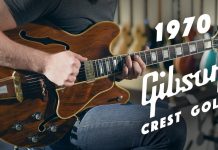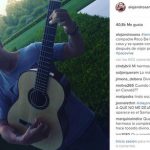The choice of material for the construction of a guitar is certainly very important and decisive for the final volume and timbre of the guitar. In classical and flamenco guitar there are different types of wood for more or less optimal timber to form the different parts of the guitar. For the soundboard is common use soft wood and for sides and back hardwoods.
Among the parts forming the sound box of an instrument, the soundboard is considered the most important part, because of their importance in the chain of sound generation. The quality of the top, its characteristics and mechanical properties can generate great differences between the final sound produced by two guitars of identical design and elaboration.
But the properties and characteristics of a soundboard not only depend on the type of wood. Woods from the same tree has different characteristics depending on the part from which it comes. Even in woods from trees belonging to the same area with very similar growth, we can take soundboards so different.
Among the parts forming the sound box of an instrument, the soundboard is considered the most important part, because of their importance in the chain of sound generation.
While elaborating two tops with the same kind of wood, with the same thickness and the same harmonic bars we can get soundboards with very different qualities. This difference is explained by the fact that two boards for a soundboard of the same wood have different acoustic characteristics, depending on their internal structure, of the age of the tree, the age from which it was cut and the type it.
The time since wood is cut until it is used in a guitar is a period for the crystallization of the cellular structure of the wood, the water disappears and substantially improves their acoustic capabilities.
All these features make the choice of wood for soundboard a complicated task, and it is at this point when de discretion of each luthier has a key role. Depending on the sound and the expected characteristics one wood or another will be chosen, with some characteristics or another. A board with a thinner, more vertical grain, uniform or wider also characterize the instrument sound in different ways.
Woods from the same tree has different characteristics depending on the part from which it comes. Even in woods from trees belonging to the same area with very similar growth, we can take soundboards so different.
The wood grain influences the final sound of the guitar, and to give it an optimal cut, the type of cut is made in a radial cut of the trunk, as if the cut boards were the pages of a book.

Obviously, there are also other aspects that affect the sound of the soundboard such as the relative humidity absorbed by the wood or the arrangement of the harmonic bars.
Among the main wood used for the elaboration of a soundboard, we can find the German spruce, with a density of 450/500 kg / m 3 and with a whitish color. The German spruce wood traditionally has been chosen for the construction of classical guitars in Europe.

We can also find woods like Canadian cedar, with a density of 350/450 kg / m 3 and brown color. A cedar top has, once placed in a guitar, a faster evolution than the spruce but shorter evolution. It is characterized by its richness in the timbre and clarity of its sound.
As we said at the beginning, for the sides and the back of the guitar hardwoods are used. With the evolution of the guitar their thicknesses were decreasing and luthiers discovered that this type of hardwoods was better for the reflection of sound waves inside the sound box.
The time since wood is cut until it is used in a guitar is a period for the crystallization of the cellular structure of the wood, the water disappears and substantially improves their acoustic capabilities.
The industrial development and the commercial relations with East and America led to the discovery of new types of tropical and exotic woods which were incorporated into the kinds of wood available guitar construction.
Among the most common woods for sides and back we can find cypress, maple or rosewood of different types.
Rio rosewood (Dalbergia nigra) has a density of 750/850 kg / m 3 (this figure is variable) ideal to form part of a resonance box, due to its clear resonance. It is the most popular guitar construction wood and is a protected species (Appendix I of the CITES treaty) which further increases its value, not only economic, but of prestige for the instrument.
This special protection not only occurs in the case of Rio rosewood, all dense wood trees are slow growing and therefore the production thereof is scarce. In fact, since 2/1/2017 all woods of the Dalbergia family (most rosewoods belong to this botanical family) have been included in Appendix II of the CITES treaty.

The Indian rosewood (dalbergia latifolia) is a wood with a similar density but slightly less dense than Rio rosewood, has a density of 600/800 kg / m 3 (this data is very variable) is brown or dark brown, it is more stable and more accessible than the Rio rosewood what makes it a cheaper wood. There are related kinds of rosewood such as Madagascar rosewood (Dalbergia baronii ), Honduras Rosewood (dalbergia stevensonii)….

Finally, mention cypress which is quite less dense than the previous, it has a density of 400/550 kg / m 3. . It is an easy material to work, with a yellowish color. This wood is the most used for the sides and back for flamenco guitars.

The above description is just a description of most used woods for classical and Flamenco guitar making, but there are more woods suitable for it, such as Padouk or coral, African blackwood, Brown ebony… It is essential that the wood used is a solid material, instead of laminated wood or other compounds, because the use or one or another can generate considerable differences in the final sound.
The industrial development and the commercial relations with East and America led to the discovery of new types of tropical and exotic woods which were incorporated into the kinds of wood available guitar construction.
The selected woods have also to provide some stability to the instrument. The choice of this, its design, and the thicknesses of the guitar should ensure that the instrument will not deform or deteriorate over time, ensure that the instrument maintains its structural straightness and minimize the effects of climatic changes such as relative humidity.
Respect to the material for other elements of the guitar, such as the neck, as a rule, is made from cedar or mahogany from Honduras because these are more stable than others and therefore better withstand the straightness of the neck.
The fingerboard, on the neck, usually is of ebony. The resistance of this material makes it optimal to support the continuous interaction over it produces by the left hand of the guitarist while playing. It has a density of 900/1100 kg / m3.
























